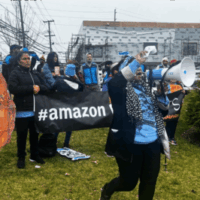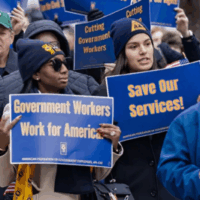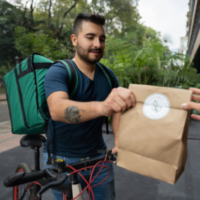14 States Have Adopted Comprehensive COVID Worker Safety Protections So Far
[Updated on June 9, 2020 with new information for Oregon.]
As the COVID-19 pandemic surges in the United States, workers have continued to protest and organize for their safety and health—but action is needed at all levels of government, starting with the top. To date, the Trump administration—specifically, the Occupational Safety and Health Administration—has resisted issuing any workplace safety standards or requirements to protect workers from COVID-19 in the workplace. In the absence of federal leadership, some governors and state health departments have stepped up to expand worker protections.
OSHA has resisted issuing any workplace safety standards or requirements to protect workers from COVID-19 in the workplace.
Some states have issued executive orders with very specific worker protection requirements, and Virginia issued a first-in-the-nation Emergency Temporary Standard to protect workers. Oregon and Michigan also have issued emergency standards. Other states have issued guidelines, some of which they intend to enforce. Some cities as well have issued protective ordinances for workers.
Many states’ executive orders (including the Virginia standard) require employers to heed the following:
- ensure physical distancing of at least six feet between employees and their coworkers and customers;
- provide face masks to all employees if maintaining six-foot social distance is not always possible;
- require customer to wear face masks;
- provide employees with other personal protective equipment in addition to face coverings;
- improve ventilation;
- provide employees with regular access to hand-washing and soap;
- have hand sanitizer readily available to workers;
- require deep cleaning after COVID cases are discovered in the workplace; and
- notify workers when cases are found.
In some states, such as Oregon, Michigan, and Nevada, enforcement is handled by state occupational safety and health agencies; in others, by health departments, labor departments, and the attorney general’s office. Some states where federal OSHA has traditionally done enforcement are still figuring out how best to enforce these protections.
Inexcusably, the Trump administration has abandoned its responsibility to ensure that workers and the general public are safe in this pandemic. As the number of workers infected with and dying from this disease continues to grow, it’s clear that a voluntary approach to worker safety is not mitigating this public health disaster.
A voluntary approach to worker safety has failed to mitigate this public health disaster.
Even while workers continue to take major risks in speaking out and organizing in their workplaces, communities of color are paying the heaviest price for this federal policy failure. Although all workers on the job now or returning to work in the near future are at risk of illness, Black and Latinx workers and other workers of color, including immigrants, are more likely to be in frontline jobs. In addition, these communities have disproportionate rates of serious illness and death related to COVID-19, stemming from structural racism over generations related to healthcare and access to care. It is crucial that state and local policymakers step up to prioritize these workers and thereby further protect communities in this pandemic.
Below is a list of the 14 states that have adopted comprehensive worker safety protections (with links to more information). In addition to these, separate executive orders requiring face masks in the workplace have been issued by some governors (e.g., North Carolina, Texas, Massachusetts), cities (e.g., Raleigh, NC), and counties. Philadelphia has also issued the first citywide ordinance protecting workers from retaliation for raising COVID-19 safety and health concerns or refusing to work under unsafe conditions related to COVID-19.
California
Cal/OSHA adopted a new emergency standard for COVID prevention on November 19, 2020:
https://www.dir.ca.gov/OSHSB/documents/COVID-19-Prevention-Emergency-apprvdtxt.pdf
https://www.dir.ca.gov/title8/5199.html (the Cal/OSHA aerosol transmission standard that covers healthcare and first-response employees)
http://file.lacounty.gov/SDSInter/bos/supdocs/147290.pdf (L.A. County Board of Supervisors approved a proposal to facilitate worker-led health councils to monitor business compliance with public health orders mitigating the spread of COVID-19 at work)
Illinois
https://www2.illinois.gov/Pages/Executive-Orders/ExecutiveOrder2020-32.aspx (initial EO issued April 30)
https://www2.illinois.gov/Pages/Executive-Orders/ExecutiveOrder2020-38.aspx (updated EO issued May 29)
http://dph.illinois.gov/covid19/community-guidance/guidance-food-and-meat-processing-facilities (issued by Illinois Department of Public Health)
From the reopening checklists now being published: “Any employee who has had close contact with co-worker or any other person who is diagnosed with COVID-19 should quarantine for 14 days after the last/most recent contact with the infectious individual and should seek a COVID-19 test at a state or local government testing center, healthcare center or other testing locations. All other employees should be on alert for symptoms of fever, cough, or shortness of breath and taking temperature if symptoms develop.”
Kentucky
https://govstatus.egov.com/ky-healthy-at-work
Massachusetts
https://www.mass.gov/info-details/reopening-mandatory-safety-standards-for-workplaces
https://www.mass.gov/forms/report-unsafe-working-conditions-during-covid-19 (complaint form)
https://www.mass.gov/service-details/covid-19-workplace-safety-measures-for-reopening
Michigan
Michigan OSHA issued Emergency Rules for COVID-19 on October 14, 2020. (See related press release.)
Two executive orders previously issued (here and here) will no longer be enforced by the state due to a Michigan Supreme Court decision on October 2nd invalidating the orders.
Minnesota
https://www.health.state.mn.us/diseases/coronavirus/businesses.html
https://www.dli.mn.gov/sites/default/files/pdf/COVID_19_business_plan_template.pdf
https://www.dli.mn.gov/sites/default/files/pdf/COVID_19_meatpacking_guidance.pdf (for meat)
https://www.leg.state.mn.us/archive/execorders/20-54.pdf (on the right to refuse work)
Nevada
http://business.nv.gov/News_Media/COVID-19_Announcements/
New Jersey
On October 28, 2020, New Jersey’s governor issued Executive Order 192 to protect New Jersey’s workers during the pandemic. The governor’s press release provides an overview.
This comes on top of an earlier executive order issued on April 8, 2020 requiring essential retail businesses and industries to take steps to limit the spread of COVID-19, among other things. (The state is also updating industry-specific guidance.)
New York
https://agriculture.ny.gov/system/files/documents/2020/04/retailfoodstoreguidanceforseniors_1.pdf (some essential industries remain without guidance)
Oregon
On May 4, 2021, Oregon OSHA adopted a permanent COVID-19 standard:
https://osha.oregon.gov/OSHARules/adopted/2021/ao2-2021-letter-cov19-allworkplaces.pdf
On November 6, 2020, Oregon OSHA adopted a new COVID-19 emergency temporary rule addressing COVID-19 workplace risks.
This follows previous executive orders issued during the pandemic:
– https://www.oregon.gov/gov/admin/Pages/eo_20-12.aspx (executive order)
– https://osha.oregon.gov/news/2020/Pages/nr2020-19.aspx (Oregon OSHA)
– https://www.wweek.com/news/2020/07/01/oregon-osha-to-enforce-mask-rules/ (enforcing the EO)
Pennsylvania
https://www.governor.pa.gov/covid-19/business-guidance/
https://www.governor.pa.gov/wp-content/uploads/2020/04/20200415-SOH-worker-safety-order.pdf
https://www.jacksonlewis.com/sites/default/files/docs/PhiladelphiaCertifiedCopy20032801.pdf (Philadelphia ordinance that includes retaliation protections for raising concerns or refusing unsafe work; plus private right of action)
Rhode Island
https://reopeningri.com/vital-workplace-resources
Virginia
https://www.doli.virginia.gov/wp-content/uploads/2021/01/Final-Standard-for-Infectious-Disease-Prevention-of-the-Virus-That-Causes-COVID-19-16-VAC25-220-1.27.2021.pdf (Virginia issued a Final Permanent Standard for preventing COVID-19, effective January 27. 2021)
https://www.doli.virginia.gov/wp-content/uploads/2020/07/COVID-19-Emergency-Temporary-Standard-FOR-PUBLIC-DISTRIBUTION-FINAL-7.17.2020.pdf (Virginia OSH passed the nation’s first Emergency Temporary Standard for workers, effective the week of July 27, 2020)
Washington State
https://www.governor.wa.gov/sites/default/files/COVID19AgriculturalSafetyPlan.pdf (COVID protections for farmworkers)
https://www.doh.wa.gov/Portals/1/Documents/4300/TWH-RevisedRule-9-10-2020.pdf (revised emergency rule on temporary worker housing)
https://www.governor.wa.gov/issues/issues/covid-19-resources/covid-19-reopening-guidance-businesses-and-workers (this is written as enforceable guidance)
https://www.lni.wa.gov/safety-health/safety-rules/enforcement-policies/DD170.pdf (enforcement)




